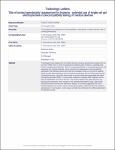‘Site of contact genotoxicity’ assessment for implants - Potential use of single cell gel electrophoresis in biocompatibility testing of medical devices
| dc.contributor.author | Jha, Awadhesh | |
| dc.contributor.author | Kumaravel, TS | |
| dc.contributor.author | Brabu, B | |
| dc.contributor.author | Parthiban, N | |
| dc.contributor.author | Murugan, SS | |
| dc.date.accessioned | 2023-06-20T12:24:07Z | |
| dc.date.available | 2023-06-20T12:24:07Z | |
| dc.date.issued | 2021-05-01 | |
| dc.identifier.issn | 1879-3169 | |
| dc.identifier.uri | https://pearl.plymouth.ac.uk/handle/10026.1/20989 | |
| dc.description.abstract |
Toxicological risk assessment of medical devices requires genotoxicity assessment as per ISO 10993, Part 3, which is designed to address gene mutations, clastogenicity and/or aneugenicity endpoints. ‘Site of contact genotoxicity’ is a potential genotoxic risk especially for medical implants, that is currently not addressed in biocompatibility standards. We therefore performed initial validation study on the use of alkaline single cell gel electrophoresis (comet assay) for detecting ‘site of contact genotoxicity’ of medical devices, using test items made of acrylic implants impregnated with ethyl methanesulphonate (EMS). Comet assay detected increased DNA migration at the site of implantation, but not in the liver. The same implants also failed to show any genotoxicity potentials, when tested on the standard test battery using Salmonella/microsome and chromosome aberration assays. The study suggested that some medical implants can cause ‘site of contact genotoxicity’, without producing systemic genotoxicity. In conclusion, comet assay will add new dimension to safety assessment of medical devices, and this assay can be added to the battery of genetic toxicology tests for evaluating biocompatibility of medical implants. | |
| dc.publisher | Elsevier | |
| dc.title | ‘Site of contact genotoxicity’ assessment for implants - Potential use of single cell gel electrophoresis in biocompatibility testing of medical devices | |
| dc.type | journal-article | |
| plymouth.journal | Toxicology Letters | |
| dc.identifier.doi | 10.1016/j.toxlet.2021.01.024 | |
| plymouth.organisational-group | |Plymouth | |
| plymouth.organisational-group | |Plymouth|Research Groups | |
| plymouth.organisational-group | |Plymouth|Faculty of Science and Engineering | |
| plymouth.organisational-group | |Plymouth|Faculty of Science and Engineering|School of Biological and Marine Sciences | |
| plymouth.organisational-group | |Plymouth|Research Groups|Marine Institute | |
| plymouth.organisational-group | |Plymouth|REF 2021 Researchers by UoA | |
| plymouth.organisational-group | |Plymouth|Users by role | |
| plymouth.organisational-group | |Plymouth|Users by role|Academics | |
| plymouth.organisational-group | |Plymouth|REF 2021 Researchers by UoA|UoA06 Agriculture, Veterinary and Food Science | |
| plymouth.organisational-group | |Plymouth|Admin Group - REF | |
| plymouth.organisational-group | |Plymouth|Admin Group - REF|REF Admin Group - FoSE | |
| plymouth.organisational-group | |Plymouth|Users by role|Researchers in ResearchFish submission | |
| dcterms.dateAccepted | 2021-01-30 | |
| dc.date.updated | 2023-06-20T12:24:07Z | |
| dc.rights.embargodate | 2023-6-21 | |
| dc.rights.embargoperiod | forever | |
| rioxxterms.versionofrecord | 10.1016/j.toxlet.2021.01.024 |


